2nd arrondissement of Paris
The 2nd arrondissement of Paris (IIe arrondissement) is one of the 20 arrondissements of the capital city of France. In spoken French, this arrondissement is colloquially referred to as deuxième (second/the second).
2nd arrondissement of Paris IIe arrondissement | |
|---|---|
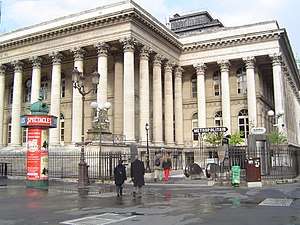 The former Paris Bourse | |
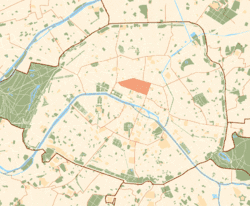 Paris and its closest suburbs | |
| Country | France |
| Region | Île-de-France |
| Department | Paris |
| Commune | Paris |
| Government | |
| • Mayor of Paris Centre | Ariel Weil (PS) |
| Area | |
| • Total | 0.99 km2 (0.38 sq mi) |
| Population (2017-01-01)[1] | |
| • Total | 20,900 |
| • Estimate (2005) | 20,700 |
| • Density | 21,000/km2 (55,000/sq mi) |
| 1 Population sans doubles comptes: single count of residents of multiple communes (e.g. students and military personnel). | |
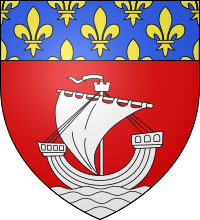 Paris Coat of Arms 20 arrondissements of Paris | |||||||||||||||||||||||||||||||||||||
|---|---|---|---|---|---|---|---|---|---|---|---|---|---|---|---|---|---|---|---|---|---|---|---|---|---|---|---|---|---|---|---|---|---|---|---|---|---|
| |||||||||||||||||||||||||||||||||||||
Also known as Bourse, this arrondissement is located on the right bank of the River Seine. The 2nd arrondissement, together with the adjacent 8th and 9th arrondissements, hosts an important business district, centred on the Paris Opéra, which houses the city's most dense concentration of business activities. The arrondissement contains the former Paris Bourse (stock exchange) and several banking headquarters, as well as a textile district, known as the Sentier, and the Opéra-Comique's theatre, the Salle Favart. The 2nd arrondissement is the home of Grand Rex, the largest movie theater in Paris.[2]
The 2nd arrondissement is also the home of most of Paris's surviving 19th-century glazed commercial arcades. At the beginning of the 19th century, most of the streets of Paris were dark, muddy, and lacked sidewalks. A few entrepreneurs copied the success of the Passage des Panoramas and its well-lit, dry, and paved pedestrian passageways. By the middle of the 19th century, there were about two dozen of these commercial malls, but most of them disappeared as the Paris authorities paved the main streets and added sidewalks, as well as gas street lighting. The commercial survivors are – in addition to the Passage des Panoramas – the Galerie Vivienne, the Passage Choiseul, the Galerie Colbert, the Passage des Princes, the Passage du Grand Cerf, the Passage du Caire, the Passage Lemoine, the Passage Jouffroy, the Passage Basfour, the Passage du Bourg-L'abbé, and the Passage du Ponceau.
Geography
The 2nd arrondissement is Paris's smallest arrondissement, with a land area of just 0.992 km2 (0.383 sq. miles, or 245 acres)
Demographics
The 2nd arrondissement reached its peak of settlement in the years before 1861, although it has only existed in its current shape since the re-organization of Paris in 1860. As of the last census (in 1999), the population was 19,585, while the number of jobs provided there was 61,672 – this despite a land area of only 0.992 km2, making it the arrondissement with the densest concentration of commercial activity in the capital, with an average of 62,695 jobs per km2.
Historical population
| Year (of French censuses) |
Population | Density (inh. per km2) |
|---|---|---|
| 1861 (peak of population)¹ | 81,609 | 82,267 |
| 1872 | 73,578 | 74,321 |
| 1954 | 41,780 | 44,300 |
| 1962 | 40,864 | 41,194 |
| 1968 | 35,357 | 35,642 |
| 1975 | 26,328 | 26,540 |
| 1982 | 21,203 | 21,374 |
| 1990 | 20,738 | 20,905 |
| 1999 | 19,585 | 19,743 |
| 2009 | 22,400 | 22,626 |
¹The peak of population actually occurred before 1861, but the
arrondissement was created in 1860, so we do not have figures before 1861.
Immigration
| Born in Metropolitan France | Born outside Metropolitan France | |||
|---|---|---|---|---|
| 71.4% | 28.6% | |||
| Born in Overseas France |
Born in foreign countries with French citizenship at birth1 | EU-15 immigrants2 | Non-EU-15 immigrants | |
| 0.8% | 3.8% | 6.1% | 17.9% | |
| 1 This group is made up largely of former French settlers, such as pieds-noirs in Northwest Africa, followed by former colonial citizens who had French citizenship at birth (such as was often the case for the native elite in French colonies), and to a lesser extent foreign-born children of French expatriates. Note that a foreign country is understood as a country not part of France in 1999, so a person born for example in 1950 in Algeria, when Algeria was an integral part of France, is nonetheless listed as a person born in a foreign country in French statistics. 2 An immigrant is a person born in a foreign country not having French citizenship at birth. Note that an immigrant may have acquired French citizenship since moving to France, but is still considered an immigrant in French statistics. On the other hand, persons born in France with foreign citizenship (the children of immigrants) are not listed as immigrants. | ||||
Economy
The French newspaper L'Obs has its head office in the arrondissement.[3] Bourbon has its head office in the arrondissement.[4] All Nippon Airways has its Paris Office in the arrondissement.[5] China Airlines also has its France office in the arrondissement.[6]
Aigle Azur's registered office is in the arrondissement.[7]
Education

In terms of state-operated schools, the second arrondissement has three nursery schools (écoles maternelles), five primary schools (écoles élémentaires), and one high school (collège).[8]
The nursery schools are École Maternelle Dussoubs, École Maternelle Saint Denis, and École Maternelle Vivienne.[8] The primary schools are École Élémentaire Beauregard, École Élémentaire Dussoubs, École Élémentaire Etienne Marcel, École Élémentaire Jussienne, and École Élémentaire Louvois.[8] Collège César Franck is the sole state-operated high school in the arrondissement.[9]
École Élémentaire Privée Saint-Sauveur is the sole private primary school institution in the second arrondissement. Private secondary school institutions include École du 2nd Degré Général Privée Rene Reaumur, École Générale et Technologique Privée Lafayette, École du 2nd degré professionnel privée CTRE PRI ENS SOINS ESTHETIQUES, École du 2nd degré professionnel privée EC INTERNATIONALE DE COIFFURE, École du 2nd degré professionnel privée ECOLE DE BIJOUTERIE-JOAILLERIE, and École technologique privée ITECOM INST TECHN COMMUNIC.[8]
Map

Cityscape
Places of interest in the arrondissement
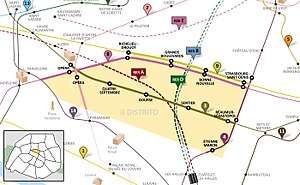
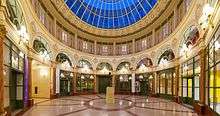
- Bibliothèque nationale de France historical building (site Richelieu) (Monument historique)
- Galerie Colbert
- Opéra-Comique
- Paris stock exchange (Palais Brongniart, former headquarters)
- Passage des Panoramas
- Théâtre des Bouffes Parisiens
- Théâtre des Variétés
- Théâtre-Musée des Capucines, a perfume museum
- Tour Jean sans Peur, the last vestige of the Hôtel de Bourgogne
Former buildings in the arrondissement
- Salle Feydeau
- Salle de la Bourse
- Théâtre de l'Hôtel de Bourgogne
Main streets and squares
- Rue de la Banque
- Place de la Bourse
- Boulevard de Bonne-Nouvelle
- Boulevard des Capucines
- Rue des Capucines
- Rue de Cléry
- Rue Étienne-Marcel
- Rue du Faubourg-Montmartre
- Boulevard des Italiens
- Rue du Louvre
- Rue Monsigny
- Boulevard Montmartre
- Rue Montmartre
- Rue Montorgueil
- Rue Notre-Dame des Victoires
- Avenue de l'Opéra (partial)
- Rue de la Paix
- Rue des Petits-Champs
- Boulevard Poissonnière
- Rue du Quatre-Septembre
- Rue Réaumur
- Rue de Richelieu (partial)
- Boulevard Saint-Denis
- Rue Saint-Denis
- Rue Saint-Sauveur
- Boulevard Sébastopol
- Rue de Turbigo
- Place des Victoires (partial)
References
- "Populations légales 2017". INSEE. Retrieved 6 January 2020.
- "Movie theaters in Paris". Paris Digest. 2018. Retrieved 2018-11-21.
- "Mentions Légales du Nouvelobs.com." L'Obs. Retrieved on March 1, 2016. "dont le siège est 10-12, place de la Bourse, 75002 PARIS"
- "Contacts Archived 2011-07-06 at the Wayback Machine." Bourbon. Retrieved on 2 February 2011. "Head Office 33, rue du Louvre – 75002 Paris FRANCE."
- "ANA City Offices/Ticketing Offices Europe." All Nippon Airways. Retrieved on 13 August 2011. "Paris Office 29-31 Rue St. Augustin 75002 Paris "
- "Europe and Middle East Archived 2011-09-26 at the Wayback Machine." China Airlines. Retrieved on August 30, 2011. "France 17 Rue du Quatre Septembre,75002 Paris, France."
- "Contactez-nous." Aigle Azur. Retrieved on 6 January 2011. "Siège Social 36 rue des Jeûneurs 75002 - France" and "Services Administratifs 4 avenue Marcel Paul 93297 Tremblay en France - France"
- "Rechercher un établissement Archived 2011-12-04 at the Wayback Machine." Académie Paris. Retrieved on 25 October 2011.
- "Accueil." Collège César Franck. Retrieved on 25 October 2011. "Infos Collège COLLEGE CESAR FRANCK 7 RUE DE LA JUSSIENNE 75002"
- Le Guide du routard 2006: Paris.
- 54 Promenades en Famille. A Paris et en Île-de-France.
External links

| Wikimedia Commons has media related to Paris 2e arrondissement. |